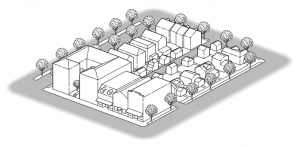Why Design Guidelines, On Their Own, Don’t Work
Originally published in Better! Cities & Towns, 22 December 2010.
While lifting federal funding restrictions on stem cell research President Obama said, “we will develop strict guidelines, which we will rigorously enforce, because we cannot ever tolerate misuse or abuse.” Notwithstanding the political rhetoric, are standards different than strict guidelines? Can guidelines be rigorously enforced? In common usage, the terms “guidelines” and “standards” are frequently used interchangeably. However, within the development regulatory framework, a guideline is a helpful suggestion — you don’t have to follow it, but it is recommended. On the other hand, standards are legal and mandatory requirements.
Design Guidelines

Conventional Zoning
Density use, FAR (floor area ratio), setbacks, parking requirements, maximum building heights specified
Guidelines are explanatory and interpretive recommendations that encourage, not require, its use. Administered through appointed design review committee, commission, or advisory board, guidelines are created to fit a wide range of situations, but not all. Guidelines are typically attractive to cities that are not politically ready to enforce design standards. Guidelines are also preferred by designers who have little tolerance for any standard that tends to limit their creative expression. Good judgment is needed in deciding where and how to apply design guidelines.

Zoning Design Guidelines
Conventional zoning requirements, plus frequency of openings and surface articulation specified
The problem with design guidelines is that their application is skin deep and fails to breathe life and soul into a place. The diagram (to the right) illustrates the differences between conventional zoning, design guidelines, and form-based codes. The building block (top image) complies with typical zoning controls such as land use, FAR, and height. This block is not likely to create walkable urbanism. At best, design guidelines (middle image) can recommend articulation and openings to the building’s facade. In contrast, Form-Based Codes (bottom image) conceptualize a public realm by pulling together the individual elements: the diverse street types, variety of public and private open spaces, and contextual building types into a complete, cohesive, and memorable place.

Form-Based Codes
Street and building types (or mix of types), build-to lines, number of floors, and percentage of built site frontage specified.
A key barrier to protecting and creating distinctive places is lack of clear and precise place-based standards and a predictable review process. Design guidelines are difficult to apply consistently. They offer too much room for subjective interpretation. Design guidelines are difficult to enforce. A developer can legally refuse to comply putting at risk the larger collective investments of neighboring properties. Design Guidelines require oversight by discretionary review bodies, leading to a protracted and politicized planning process that can cost time and money.
Form-Based Codes
Form-Based Codes (FBCs) are clear and precise standards that offers predictability. The FBCs are developed to create a specific place that the citizens desire. Both the vision and FBCs are developed with citizen input. The citizens have a higher comfort level with the end result the standards is likely to produce. City staff gets a streamlined and easy to administer review process. FBCs also create more choices, more opportunities and options for the property owner. Typically, developers borrow money to pursue pre-construction work. For developers, time is money. The biggest incentive that cities can offer is not money, but clear and predictable development standards. Most developers are willing to build to higher standards if the rules are clear and the process is predictable. By offering adjacent predictable environment FBCs reduce risks where banks in this credit-starved economy may be more willing to loan construction money.
Conclusion
Design Guidelines can be added to complement Form-Based standards to address certain discretionary items such as architectural style and historic preservation. The Denver Commons Form-Based Code, recognized with the 2009 Form-Based Codes Institute’s Driehaus Award, includes both standards and guidelines. The mandatory standards address the critical form related aspects that shape the public realm, while the guidelines provide further suggestive recommendations for enhancing the public realm experience by encouraging creativity in a flexible manner.
Louis Kahn called a street “a room by agreement.” The agreement, in the form of binding standards, is an implicit consent between the architects and their buildings to not ignore the street but to bring forth a collective etiquette and a minimum capability to pull together buildings to shape and enhance the public realm.
By itself, the guidelines simply fail to deliver great places. The terms “strict guidelines” fail to inspire compliance. The “abuse and misuse” continues with discretionary review and unpredictable outcome fueling NIMBY sentiments and discouraging economic development. Design guidelines work best only when they are paired with form-based codes.














